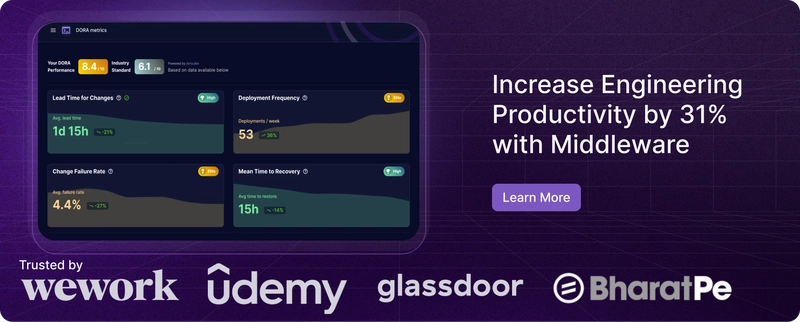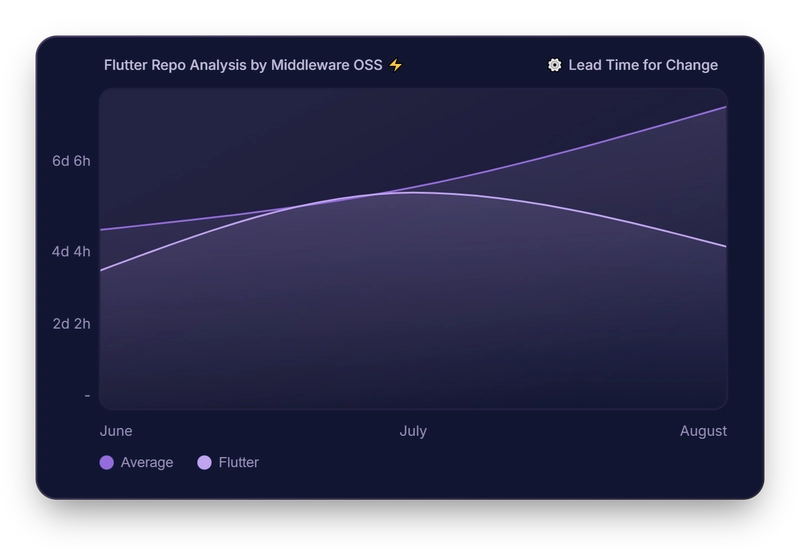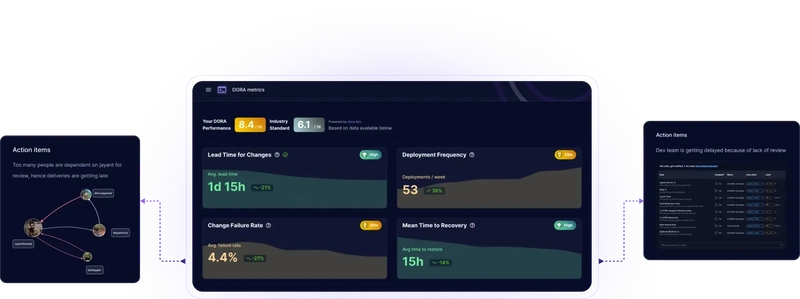If you've ever found yourself lost in the endless abyss of project timelines, wondering why things take longer than expected, you're not alone. Understanding Cycle Time and Lead Time can be the key to unlocking efficiency and keeping your projects on track. These two time-based metrics are the unsung heroes of project management, software development, and manufacturing---but they're often misunderstood.
So, let's break it down in the simplest, no-nonsense way.
Want to take your development efficiency to the next level? Try Middleware today and see how precise tracking of Lead Time and Cycle Time can supercharge your software delivery process! Book a demo now!
What is Lead Time?
Lead Time is the granddaddy of all time-tracking metrics. It measures the total time taken from the moment a request is made (think of placing an order) to when the final product is delivered. In software development, it's the time from when a feature is requested to when it's deployed.
Note: The above image is from a Dora Metrics case study we did on Flutter open source repository. Learn more on Flutter's Engineering Pipeline: A Great Workflow with Minor Hiccups
Example:
Imagine ordering a pizza. The Lead Time starts the moment you place the order and includes the entire process: prepping, baking, boxing, and finally, delivery to your doorstep. Learn more on Lead Time for Changes: A Deep Dive Into DORA Metrics & Their Impact on Software Delivery
What is Cycle Time?
Cycle Time is a more focused metric that measures the time it takes to complete a task once work begins. Unlike Lead Time, which includes waiting periods, Cycle Time starts ticking only when actual work begins.
Cycle time typically includes time spent on rework, reviews, and other activities that are part of the overall process from start to finish, not just the core work itself.
Example:
Going back to our pizza analogy, Cycle Time starts when the chef begins making your pizza and stops when it's ready to leave the oven. The delivery time? Not part of Cycle Time---that's still within Lead Time.
Why Do These Metrics Matter in Efficient Software Delivery?
If you're running a business, managing a team, or simply trying to meet deadlines, tracking both metrics can help you:
Identify bottlenecks: Long Lead Times might indicate delays in starting work, while long Cycle Times suggest inefficiencies in execution.
Improve predictability: Knowing how long things take from start to finish allows better planning and resource allocation.
Optimize workflow: Shortening Cycle Time can improve efficiency, while reducing Lead Time enhances customer satisfaction.
How Middleware Tracks Lead Time and Cycle Time for Software Development Efficiency?
Middleware provides an in-depth analysis of both Lead Time and Cycle Time, helping engineering teams optimize their development pipelines. With automated tracking and visualization tools, Middleware allows teams to:
Monitor real-time data: Get instant insights into how long it takes to move tasks from ideation to deployment.
Identify inefficiencies: Spot delays in development, code review, or deployment processes and take corrective action.
Optimize team workflows: Middleware helps teams fine-tune their development process by pinpointing the exact stages causing slowdowns.
Improve sprint planning: By analyzing historical data on Cycle and Lead Times, teams can better predict delivery timelines and allocate resources effectively.
By leveraging Middleware, software teams can enhance their efficiency, speed up deployments, and ensure a smoother workflow from request to release. Whether you're managing a startup or a large-scale enterprise, tracking these metrics with Middleware provides the clarity needed to make data-driven decisions and keep your development process running like a well-oiled machine.
Also read: How Qoala Optimized their Development Pipeline with Middleware
How to Reduce Lead Time and Cycle Time?
Streamline processes: Automate repetitive tasks and reduce unnecessary approvals.
Improve prioritization: Ensure high-priority work starts as soon as possible.
Remove roadblocks: Identify dependencies and clear them in advance.
Adopt agile methodologies: Regular iterations and feedback loops help speed up both Lead and Cycle Times.
Final Thoughts
While Lead Time and Cycle Time may seem like minor details, they play a major role in overall project success. Think of them as your project's fitness tracker---giving you valuable insights into where time is spent and where improvements can be made. Whether you're developing software, manufacturing products, or delivering pizzas, mastering these metrics will help you move faster, smarter, and with fewer surprises.
So, next time someone asks why a project is taking so long, you'll know exactly where to look!
Want to take your development efficiency to the next level? Try Middleware today and see how precise tracking of Lead Time and Cycle Time can supercharge your software delivery process! 🚀 Book a demo now!
FAQs
What is the difference between Lead Time and Cycle Time?
Lead Time is the total time from when a request is made to when the final product is delivered. Cycle Time, on the other hand, only measures the time from when work begins to when it is completed, excluding waiting periods.
What is the difference between WIP and Lead Time?
Work In Progress (WIP) refers to tasks that are currently being worked on but are not yet completed. Lead Time includes WIP as well as any waiting time before work begins and after it is completed until delivery.
What are the metrics for manufacturing Cycle Time?
In manufacturing, Cycle Time metrics typically include:
Process Cycle Time: Time taken to complete one unit of production.
Machine Cycle Time: Time a machine takes to complete its function.
Lead Time to Cycle Time Ratio: Measures efficiency by comparing total Lead Time to actual work time.
Takt Time: The rate at which products must be produced to meet demand.
What is the difference between Cycle Time and Lead Time in DevOps?
In DevOps, Lead Time refers to the time from code commit to production release, including all review and testing phases. Cycle Time focuses only on active development time, from when work begins on a feature to when it is ready for deployment.








Top comments (0)